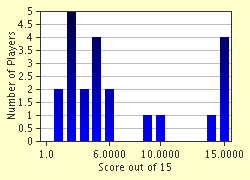Quiz Answer Key and Fun Facts
1. In what year was the First Bulgarian Empire established?
2. What was the name of the first Bulgarian ruler, credited for being the state's founder?
3. Which Bulgarian khan deserved the nickname of 'the Saviour of Europe' for leading the Bulgarian army that crushed the Arabs during the Siege of Constantinople?
4. The death of Sevar marked the end of the foremost period in the history of the First Bulgarian Empire. He was also the last lord of the Dulo dynasty to govern the country until 768, when Tervel's son Telerig was crowned. The period between those two events (Sevar's death in 753 and Telerig's coming to power in 768) was a time of internal conflicts and political instability for the country. During this term several monarchs were given the khan title, with most of them being dethroned shortly after. So, what was the exact number of the men that ruled over Bulgaria between 753 and 768 (excluding Sevar and Telerig, of course)?
5. Krum the Fearsome is deservedly considered one of Bulgaria's most notable monarchs. During the time of his reign the country doubled its size, spreading from the middle Danube to the Dnieper and from Odrin to the Tatra Mountains. He is also credited with being the author of the first written laws in the khanate. Krum's army defeated the Avarian Khaganate, which resulted in the ascertainment of a common border between Bulgaria and the Frankish Empire. Military conflicts with the Byzantine Empire also marked his rule. This led to the Byzantine emperor losing his life in the battle of the Varbica Pass. Which Byzantine potentate was killed there?
6. Which of these men is famous for being the first Bulgarian Christian martyr and also the earliest Bulgarian saint to be canonized?
7. Boris I was the Bulgarian ruler responsible for the Christianization of the country. A large group of Bulgarian boyars (local aristocrats) initiated a revolt. Boris ruthlessly repressed it and had them all killed together with their entire extended families. How many aristocratic families were slain?
8. Boris abdicated the throne in 889. Another pagan rebellion was started by his son Vladimir-Rasate. Boris came out of his retirement (he had meanwhile become a monk) and defeated the rebels. But what happened to Vladimir?
9. Vladimir-Rasate's brother Simeon was enthroned during the Council of Preslav, despite of being prepared for the priesthood before this. During his reign Bulgaria reached its greatest territorial extent. Known for his successful raids against the Magyars, the Serbs and Byzantium, he proclaimed himself "Emperor of the Bulgarians and the Romans". The Byzantine Empire, of course, recognized him only as an emperor of the former. His governance is referred to as "the Golden Age of Bulgarian culture". After his death in 927, he was succeeded by one of the following men. Which?
10. Who was the last emperor (tsar) of the First Bulgarian Empire?
11. The Uprising of Asen and Peter led to the creation of the Second Bulgarian Empire in 1185. Those two men were brothers, but the latter's birth name was actually different (he had adopted the name Peter just like two Bulgarian revolt leaders before him). So what was his real name?
12. Time for some facts. Bulgaria's coasts bordered three seas - the Adriatic, the Aegean and the Black Sea - twice in Bulgarian history (once during the time of the First Bulgarian Empire and once during the existence of the Second). Which Bulgarian monarchs made this possible? Note: FBE means First Bulgarian Empire, SBE - Second Bulgarian Empire.
13. Which Bulgarian emperor, known for defeating the Byzantines and making the Mongol forays to Bulgaria stop, is also famous for ordering the execution of a Bulgarian patriarch in the early 14th century?
14. Rulers of which dynasty that governed medieval Bulgaria were of Cuman origin?
15. To whom was the fortress of Tarnovo entrusted in the spring of 1393 in order to hold it against the Ottoman Turks?
Source: Author
blackandgreen
This quiz was reviewed by FunTrivia editor
bloomsby before going online.
Any errors found in FunTrivia content are routinely corrected through our feedback system.

